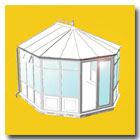Conservatory History
Conservatories are traditionally used to house exotic plants, flowers, herbs, and in some cases birds or small animals. The glass walls allow sunlight in to nourish the plants and provide a warm, bright space for entertaining or relaxing.
Georgian Design (1714-1811)
During the Georgian era, conservatories were rectangular brick or stone buildings with numerous small panes of glass framed in the walls. The classic design, influenced by earlier Greek and Roman styles, was used for both large conservatories located in parks and open to the public as part of a botanical garden as well as for the few smaller residential versions. Glass was an expensive commodity, so these private greenhouses were only available to the very wealthy.
The Orangery
Orangeries are a variation of the conservatory. Specifically designed to grow citrus trees, the orangery gets its light from the roof instead of the walls. Solid walls, often brick, are topped by a flat glass roof. Although these rooms were never as popular as the conservatory, in certain circumstances, orangeries had a distinct advantage over a conservatory. During the socially strict Victorian era, couples who wanted to be together and yet not seen, preferred the solid walls of an orangery for their clandestine meetings. The Palace of the Louvre, Versailles, Schoenbrunn in Vienna, Austria, and Kew Gardens are excellent examples of classic orangeries.
Victorian Design (1837-1901)
 The 1851 Exhibition in London featured an enormous
glass and cast iron building called Crystal Palace, which was the main
hall for the majority of displays. The wildly popular structure touched off a craze for adding conservatory rooms as home
improvements or to the garden as a stand-alone feature.
The 1851 Exhibition in London featured an enormous
glass and cast iron building called Crystal Palace, which was the main
hall for the majority of displays. The wildly popular structure touched off a craze for adding conservatory rooms as home
improvements or to the garden as a stand-alone feature.
The Victorians strayed from the rectangular shape favored by the Georgians preferring instead hexagonal or rounded shapes with steep roofs. Framed with cast iron with large panes of glass for the walls the Victorian conservatory is elegant as well as ornamental. Design details including glass fanlights, bay windows, arched doorways, and elegant cast iron eave brackets are common architectural elements.
Edwardian To The First World War (1901-1914)
Edwardian conservatories differed from the victorian by returning to the rectangular shape used prior to the ornate victorian designs.
The Modern Conservatory
Often referred to as sunrooms, modern conservatories are used as recreation rooms more often than they are for plants. Today, the material used for the majority of conservatories is unplasticised Poly Vinyl Chloride, PVCu which is easy to work with and requires less maintenance. Various colors can be added to PVCu during the manufacturing process negating the need for paint. For homeowners interested in building the room themselves, there are a number of DIY conservatory kits available.





